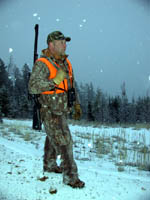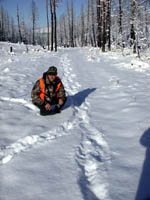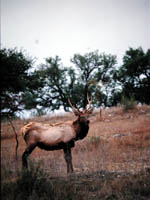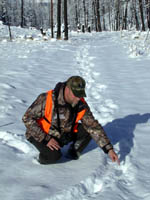
|
Features
|
|
|
|
Books
|
|
|
|
Fun & Games
|
|
|
|
Contact Us
|
|
|
John's Journal... Entry 176, Day 2
PREPARING FOR AN ELK HUNT
Puppe's Tracking Technique
 EDITOR'S
NOTE: Steve Puppe of Hamilton, Montana, promotions
director for Knight Rifles and longtime avid hunter, lives on the edge
of the Bitterroot National Forest with its abundant elk, mule deer and
white-tailed deer.
EDITOR'S
NOTE: Steve Puppe of Hamilton, Montana, promotions
director for Knight Rifles and longtime avid hunter, lives on the edge
of the Bitterroot National Forest with its abundant elk, mule deer and
white-tailed deer.
Question: How much snow have we had in the Bitterroot
Wilderness Area on this November morning?
Answer: Down here in the valley we've gotten about 4-1/2-inches. I took
a little walk out by the house this morning and noticed it was going to
be a little difficult to walk. So, when we get up to the elevation where
we'll be hunting today (around 8,000 feet), I guess we'll have 8 to 10
inches of new snow.
 Question:
Tell me the technique we'll use this morning.
Question:
Tell me the technique we'll use this morning.
Answer: With this fresh snow, first we're going to put a set of tire chains
on the truck. We're going to take some of these high-mountain roads and
either glass some of the other canyons, or look for tracks. We'll determine
how old each track is. If it is snowed in, then we'll know it is fairly
old. Several tracks mean it is just cows and calves. If we can find a
singled-out track or possibly a double track, then we'll decide whether
or not we're going to go after it. Hopefully, we'll either catch the animal
feeding or laying down in a bed somewhere.
Question: What does finding one elk track mean? What
does two elk tracks mean? And, why not follow several tracks?
 Answer:
A herd usually includes more than five animals. Generally, when you find
several tracks, they've been made by cows and calves. We'll look at the
size of the tracks as well. The size will definitely tell us whether a
bull or cow has made them. The tracks will give us a better idea about
whether they've made by a bigger animal. Usually a singled-out big track
is a bull. During the late season like this, lots of the bigger herd bulls
become loners and are not really with the herds of cows. That's why we're
not going to get too carried away if we find a bunch of tracks. Two tracks
can be two satellite-type bulls that are going to spend the winter together.
I look at those tracks pretty seriously.
Answer:
A herd usually includes more than five animals. Generally, when you find
several tracks, they've been made by cows and calves. We'll look at the
size of the tracks as well. The size will definitely tell us whether a
bull or cow has made them. The tracks will give us a better idea about
whether they've made by a bigger animal. Usually a singled-out big track
is a bull. During the late season like this, lots of the bigger herd bulls
become loners and are not really with the herds of cows. That's why we're
not going to get too carried away if we find a bunch of tracks. Two tracks
can be two satellite-type bulls that are going to spend the winter together.
I look at those tracks pretty seriously.
Question: In the mountains at 8,000 feet, what kind of
roads are we going to be on and how many miles will we cover?
 Answer:
Well, we're going to hunt on forest-service roads. When we turn off on
the main highway to start going up the forest-service road, we may hit
a track instantly. We may cover 40 or 50 miles. It's hard to determine
because the elk travel a lot. We have some areas we know they frequent.
That's where we're going to hit first and hopefully cut our drive time
down.
Answer:
Well, we're going to hunt on forest-service roads. When we turn off on
the main highway to start going up the forest-service road, we may hit
a track instantly. We may cover 40 or 50 miles. It's hard to determine
because the elk travel a lot. We have some areas we know they frequent.
That's where we're going to hit first and hopefully cut our drive time
down.
To learn more about Knight Rifles, call (641) 856-2626, write them at Knight Rifles, Customer Service Dept., 21852 Hwy J46, Centerville, IA 52544, or visit their Web site www.knightrifles.com. You can contact Scott Boulanger, a dependable, expert elk guide in this section of Montana by writing him at P.O. Box 733, Darby, Montana, 59289. You can call him at (406) 821-0017, e-mail him at elkhunter@circlekbl.com, or visit his Web site www.circlekbl.com.
TOMORROW: THE ADVANTAGES OF TRUCK HUNTING
Check back each day this week for more about PREPARING FOR AN ELK HUNT ...
Day 1 - The Benefits of
Powder
Day 2 - Puppe's Tracking Technique
Day 3 - The Advantages of Truck Hunting
Day 4 - Hunting Tracks
Day 5 - Choosing Hunting Locations